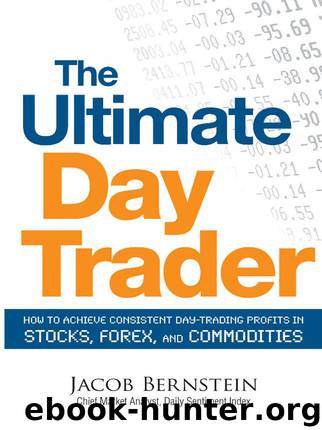The Ultimate Day Trader by Jacob Bernstein

Author:Jacob Bernstein [Bernstein, Jacob]
Language: eng
Format: epub
ISBN: 9781440513954
Publisher: Adams Business
Published: 2009-07-15T00:00:00+00:00
Figure 9.4. Price and Momentum declining in unison, Ariba Inc. stock, weekly bars. This is a normal pattern.
Figure 9.5. Price and Momentum declining in unison, JDS Uniphase stock, weekly bars. This is a normal pattern.
Figures 9.4 and 9.5 show the ideal relationship between declining prices and Momentum becoming more negative.
Remember that Momentum can fall below zero. Zero is not a stopping point for Momentum. The lower Momentum goes the lower price goes.
Furthermore, as Momentum becomes more negative, prices are likely to continue lower. Declining Momentum with price moving sideways or higher is a bearish indication since Momentum tends to lead price down as well as up (see the previous section).
It should be noted at this point that there is a logical stopping point for declining Momentum. Prices have a downside limit. The lowest price that a market can go to is zero. Naturally Momentum will eventually stop declining when the market price goes to zero. Unless a company is going bankrupt and is being de-listed from trading, there is a good possibility that as the price of a stock approaches zero (or as a commodity price gets very low) Momentum will begin to level off and turn higher. Many excellent buying opportunities in stocks and commodities develop when this occurs—more about this situation in a later chapter.
NORMAL PATTERNS: MOMENTUM AND MACD
Normal patterns are further demonstrated by looking at both the Momentum and MACD indicators in tandem. The next two charts (figures 9.6 and 9.7) show normal patterns exhibited with both Momentum and MACD.
Both of these charts show normal price and indicator patterns. They can be traded based on the idea that a move in a particular direction may be strengthening or weakening. But when price and one or both indicators diverge, that condition can signal even greater trading opportunities.
BULLISH DIVERGENCE: PRICES MOVE LOWER
AS MOMENTUM MOVES HIGHER
When price and Momentum diverge from one another, or go in opposite directions, it represents a very important trading condition. If Momentum leads price and if Momentum begins to rise while price is moving down then it’s a reasonable assumption that at some point in the future the price will move up.
Download
This site does not store any files on its server. We only index and link to content provided by other sites. Please contact the content providers to delete copyright contents if any and email us, we'll remove relevant links or contents immediately.
Bad Blood by John Carreyrou(6584)
Rich Dad Poor Dad by Robert T. Kiyosaki(6517)
Principles: Life and Work by Ray Dalio(6299)
Playing to Win_ How Strategy Really Works by A.G. Lafley & Roger L. Martin(6090)
Management Strategies for the Cloud Revolution: How Cloud Computing Is Transforming Business and Why You Can't Afford to Be Left Behind by Charles Babcock(4548)
The Confidence Code by Katty Kay(4222)
Thinking in Bets by Annie Duke(4186)
American Kingpin by Nick Bilton(3822)
Delivering Happiness by Tony Hsieh(3397)
Project Animal Farm: An Accidental Journey into the Secret World of Farming and the Truth About Our Food by Sonia Faruqi(3192)
The Power of Habit by Charles Duhigg(3097)
The Tyranny of Metrics by Jerry Z. Muller(3032)
Brotopia by Emily Chang(3029)
Mastering Bitcoin: Programming the Open Blockchain by Andreas M. Antonopoulos(3015)
The Marketing Plan Handbook: Develop Big-Picture Marketing Plans for Pennies on the Dollar by Robert W. Bly(3007)
I Live in the Future & Here's How It Works by Nick Bilton(2963)
The Content Trap by Bharat Anand(2889)
Applied Empathy by Michael Ventura(2865)
Building a StoryBrand by Donald Miller(2865)
